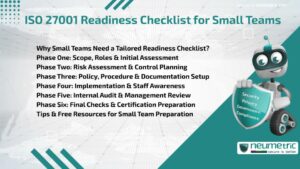Table of Contents
ToggleIntroduction
In today’s interconnected world, ensuring the security & privacy of data is more critical than ever, especially when it involves sensitive governmental information. The Federal Information Security Modernization Act [FISMA] plays a vital role in safeguarding federal data against cyber threats & ensuring that information systems across federal agencies are secure & compliant with stringent security requirements. Achieving FISMA compliance is not only crucial for federal agencies but also for contractors & vendors who handle government data.
This journal provides a thorough examination of FISMA compliance, why it matters, the steps involved in achieving compliance & the consequences of non-compliance. We’ll explore the history, key regulations, challenges & practical considerations organizations must be aware of when striving to meet FISMA’s requirements. Additionally, we’ll look at how organizations can align their existing security policies with the FISMA guidelines to prevent costly mistakes & ensure that federal information systems are secure.
What is FISMA Compliance?
The FISMA is a U.S. federal law aimed at improving the security of information systems within government agencies. FISMA was initially enacted in 2002 & later updated in 2014 to strengthen the requirements for securing federal information systems & to adapt to the evolving threat landscape. The law applies to federal agencies, their contractors & anyone working with federal data or operating federal systems, ensuring that all entities take the necessary measures to protect the Confidentiality, Integrity & Availability [CIA] of government data.
FISMA compliance requires federal agencies to adopt a risk-based approach to Information Security Management. This includes conducting regular security assessments, implementing security controls & ensuring that appropriate measures are in place to prevent, detect & respond to security incidents. FISMA aligns with other industry standards, including National Institute of Standards & Technology [NIST] guidelines, which provide detailed instructions on how to secure information systems.
The Importance of FISMA Compliance
FISMA compliance is not just a legal obligation for federal agencies & contractors. It is an essential framework to protect the confidentiality & integrity of sensitive government data. Federal Agencies hold a large amount of critical data that, if compromised, could harm national security, damage public trust & disrupt government operations.
FISMA compliance has several significant benefits:
- National Security Protection: Government systems are increasingly targeted by cybercriminals & state-sponsored actors. FISMA compliance helps reduce the risk of cyberattacks & data breaches that could compromise national security.
- Risk Mitigation: By adopting a proactive, risk-based approach to cybersecurity organizations can better identify & mitigate potential vulnerabilities before they lead to serious security breaches.
- Public Trust: FISMA ensures that federal agencies are transparent about their security practices & are actively working to protect sensitive information. This builds public trust in the government’s ability to safeguard personal & financial data.
- Avoiding Financial Penalties: Non-compliance with FISMA can result in significant penalties & legal consequences, including fines & a loss of government contracts.
Key Elements of FISMA Compliance
FISMA compliance is based on a comprehensive set of guidelines, tools & frameworks developed by the National Institute of Standards & Technology [NIST]. The most important of these is the Risk Management Framework [RMF], which provides a structured approach to managing security risks for federal information systems.
Risk Management Framework [RMF]
At the core of FISMA compliance is the Risk Management Framework [RMF], which is designed to guide organizations through the process of identifying, assessing & managing risks to their information systems. The RMF consists of six steps:
- Categorize the Information System: First organizations need to categorize the information system based on the potential impact a security breach would have. Systems are typically categorized as low, moderate or high impact, depending on the severity of the consequences of a breach.
- Select Security Controls: Next organizations must choose appropriate security controls based on the system’s categorization. These controls are derived from NIST’s Special Publication 800-53, which outlines a comprehensive set of security controls across eighteen (18) families.
- Implement Security Controls: Once security controls have been selected organizations must implement them in their information systems. This step often involves configuring firewalls, encryption mechanisms, access controls & other technical measures.
- Assess Security Controls: After implementation organizations must assess the effectiveness of the security controls. This typically involves vulnerability assessments, penetration testing & risk analysis to determine whether the controls adequately address identified risks.
- Authorize Information Systems: In this step, the Authorizing Official [AO] must review the security measures & authorize the system to operate. This is based on the understanding that the system has been adequately protected against security risks.
- Continuous Monitoring: Once authorized, systems require continuous monitoring to ensure that security controls remain effective & that new risks or vulnerabilities are identified & addressed promptly.
NIST Special Publication 800-53
The NIST SP 800-53 provides a set of detailed security controls that federal agencies must follow to secure their information systems. These controls are categorized into eighteen (18) families, each addressing a specific area of security, such as:
- Access Control [AC]: Ensures that only authorized individuals have access to sensitive systems & data.
- Incident Response [IR]: Specifies the protocols for identifying, reporting & responding to security incidents, including breaches & attacks.
- System & Communications Protection [SC]: Addresses the need for securing the communication & transmission of sensitive data.
- Contingency Planning [CP]: Ensures that organizations are prepared for the eventuality of a disaster or major security breach, with recovery plans in place.
FISMA compliance involves adhering to these guidelines & implementing them based on the risk level of the information system.
Achieving FISMA Compliance: A Step-by-Step Guide
Achieving & maintaining FISMA compliance requires a structured approach, beginning with understanding the federal security requirements & proceeding through each phase of the Risk Management Framework. Below, we explore the key steps involved in this process.
Categorizing Information Systems
The first step toward FISMA compliance is identifying & categorizing the information systems that store, process or transmit federal data. Federal agencies must classify these systems based on their security impact level. The impact levels—low, moderate or high—define the amount of protection the system needs.
- Low-impact systems are those where a breach would cause minimal harm or disruption.
- Moderate-impact systems could lead to moderate disruption or damage.
- High-impact systems are those where the impact of a security breach would be severe, such as national security systems or critical infrastructure.
This classification sets the foundation for implementing the appropriate security controls.
Selecting & Implementing Security Controls
Once systems are categorized, the next step is to select appropriate security controls from the NIST SP 800-53 catalog. The security controls selected will depend on the system’s impact level. Higher-impact systems will require more robust controls, such as Multi-Factor Authentication [MFA], advanced encryption & Intrusion Detection Systems [IDS].
After selecting the necessary controls organizations must implement them across their systems. This may include configuring firewalls, access controls, antivirus software & other technical measures designed to prevent unauthorized access & secure sensitive data.
Assessing the Effectiveness of Security Controls
Once the controls are in place, the next phase involves assessing their effectiveness. Organizations should conduct security assessments to identify any weaknesses or gaps in their security posture. This can include regular vulnerability scans, penetration testing & other assessments designed to expose potential threats before they result in a breach.
Authorization to Operate
After the security controls have been implemented & assessed organizations must seek authorization from an Authorizing Official [AO]. The AO will review the security posture of the information system, ensuring that the risks have been adequately addressed & formally authorize the system to operate.
Continuous Monitoring
FISMA compliance does not end with authorization. Federal agencies are required to continuously monitor their information systems for potential security risks. This includes regular vulnerability assessments, security audits & updates to security controls to keep up with emerging threats.
Challenges in Achieving FISMA Compliance
Achieving FISMA compliance can be challenging for several reasons. Below, we explore some of the key hurdles organizations face & offer solutions to overcome them.
Complexity of Requirements
The security controls outlined in NIST SP 800-53 can be complex & overwhelming, especially for organizations that are new to FISMA compliance. Navigating these requirements requires a detailed understanding of federal security standards, which can be daunting without dedicated cybersecurity resources. To overcome this organizations can work with compliance experts or consultants who specialize in federal information security standards.
Resource Constraints
FISMA compliance requires significant investment in cybersecurity infrastructure, staff & training. Smaller agencies or contractors may struggle with the financial & human resources necessary to meet the stringent security controls required by FISMA. One solution is to partner with Managed Security Service Providers [MSSPs] or outsource certain compliance tasks to specialized firms.
Evolving Cyber Threats
Cyber threats are constantly evolving & staying ahead of emerging risks is a continuous challenge. Organizations must be proactive in updating security measures & training staff to recognize new threats. Continuous monitoring & timely updates to security systems are critical to staying compliant with FISMA.
Consequences of Non-Compliance with FISMA
Non-compliance with FISMA can have severe consequences. Organizations that fail to meet FISMA requirements may face:
- Financial Penalties: Agencies that fail to comply with FISMA may incur significant fines or penalties.
- Loss of Government Contracts: Contractors who do not meet FISMA compliance may lose their eligibility for federal contracts, impacting their business operations.
- Reputational Damage: Failing to comply with security regulations can tarnish an organization’s reputation, especially if a breach occurs due to inadequate security measures.
- Legal & Regulatory Action: Non-compliance may lead to legal action, including lawsuits & investigations by regulatory bodies.
Conclusion
FISMA compliance is a critical requirement for federal agencies & contractors handling sensitive government data. The consequences of failing to comply with FISMA can be dire, including financial penalties, reputational damage & loss of business. By following the structured approach outlined by the Risk Management Framework [RMF] & adhering to NIST security standards organizations can ensure that they meet FISMA’s rigorous requirements & protect the government’s valuable information assets.
Achieving FISMA compliance requires investment in cybersecurity resources, a proactive risk management strategy & continuous monitoring of security controls. By adopting these practices organizations can mitigate the risks of cyber threats & help protect sensitive federal information from being compromised.
Key Takeaways
- FISMA compliance is essential for any organization handling federal data & information systems.
- The Risk Management Framework [RMF] is the foundation of FISMA compliance, guiding organizations through the process of identifying, assessing & mitigating security risks.
- Continuous monitoring & regular security assessments are crucial for maintaining FISMA compliance.
- Non-compliance can result in serious consequences, including financial penalties & loss of government contracts.
Frequently Asked Questions [FAQ]
What is FISMA compliance?
FISMA compliance ensures that federal information systems are properly protected & that security measures are in place to mitigate risks & prevent cyber threats.
Who must comply with FISMA?
FISMA applies to all federal agencies & contractors handling government data or managing federal information systems.
How do I get FISMA compliant?
FISMA compliance requires following the Risk Management Framework [RMF], selecting & implementing appropriate security controls, conducting security assessments & continuously monitoring your systems for vulnerabilities.
What happens if an organization fails to meet FISMA requirements?
Failure to comply can result in severe penalties, loss of contracts & reputational damage.
Can a third-party assist in achieving FISMA compliance?
Yes, many organizations seek the assistance of cybersecurity consultants or Managed Security Service Providers [MSSPs] to help navigate the complexities of FISMA compliance.




